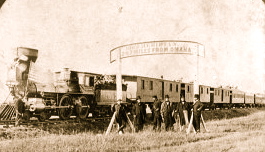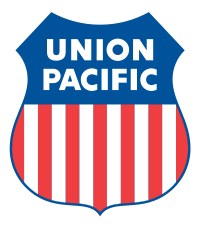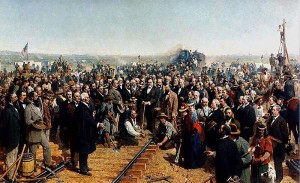Union Pacific Railroad

Union Pacific:Building America for 150 Years
When Abraham Lincoln signed the Pacific Railroad Act in 1862, UP began a mission to unite the nation from east to west. Today and tomorrow, our efforts are no less ambitious: serve our customers, supporting thousands of communities, Building America. For more information about the history of UP and our 150th anniversary celebration, visit http://up150.com.
 The Union Pacific Railroad (reporting mark UP) is a Class I line haul freight railroad that operates 8,400 locomotives over 31,390 route-miles in 23 states west of Chicago, Illinois and New Orleans, Louisiana. The Union Pacific Railroad network is the largest in the United States and is serviced by 45,700 employees.
The Union Pacific Railroad (reporting mark UP) is a Class I line haul freight railroad that operates 8,400 locomotives over 31,390 route-miles in 23 states west of Chicago, Illinois and New Orleans, Louisiana. The Union Pacific Railroad network is the largest in the United States and is serviced by 45,700 employees.
Union Pacific Railroad is the principal operating company of Union Pacific Corporation (NYSE: UNP); both are headquartered in Omaha, Nebraska. Over the years Union Pacific Corporation has grown by acquiring other railroads, notably the Missouri Pacific, Chicago and North Western, Western Pacific, Missouri-Kansas-Texas, and the Southern Pacific (including the Rio Grande). Union Pacific Corporation also owns a 26% interest in Mexico-based Ferromex.
Union Pacific Corporation’s leading railroad competitor is the BNSF Railway, which covers much of the same territory.
The current chairman of Union Pacific Corporation is James R. Young.
History
The original company, before merging with the Central Pacific Railroad, was incorporated on July 1, 1862 under an act of Congress entitled Pacific Railroad Act of 1862. The act was approved by President Abraham Lincoln, and it provided for the construction of railroads from the Missouri River to the Pacific as a war measure for the preservation of the Union. It was constructed westwardly from Council Bluffs, Iowa to meet the Central Pacific line, which was constructed eastwardly from San Francisco Bay. The line was constructed primarily by Irish labor who had learned their craft during the recent Civil War. The two lines were joined together at Promontory Summit, Utah, fifty-three miles west of Ogden on May 10, 1869, hence creating the first transcontinental railroad in North America. Under the guidance of its dominant stockholder Dr. Thomas Clark Durant, the namesake of the city of Durant, Iowa, the first rails were laid in Omaha. Subsequently, UP took over three Mormon-built roads: the Utah Central Railroadextending south from Ogden, Utah, to Salt Lake City, the Utah Southern Railroad extending south from Salt Lake City into the Utah Valley, and the Utah Northern Railroad extending north from Ogden into Idaho; and it built or absorbed local lines that gave it access to Denver and to Portland, Oregon, and the Pacific Northwest. It acquired the Kansas Pacific (originally called the Union Pacific, Eastern Division, though in essence a separate railroad). It also owned narrow gauge trackage into the heart of the Colorado Rockies and a standard gauge line south from Denver across New Mexico into Texas (both parts of the Union Pacific, Denver and Gulf Railway).
 The Last Spike, by Thomas Hill, (1881)
The Last Spike, by Thomas Hill, (1881)
 Directors of the Union Pacific Railroad gather on the 100th meridian, which later became Cozad, Nebraska, approximately 250 miles (400km) west of Omaha, Nebraska Territory, in October 1866. The train in the background awaits the party of Eastern capitalists, newspapermen, and other prominent figures invited by the railroad executives.
Directors of the Union Pacific Railroad gather on the 100th meridian, which later became Cozad, Nebraska, approximately 250 miles (400km) west of Omaha, Nebraska Territory, in October 1866. The train in the background awaits the party of Eastern capitalists, newspapermen, and other prominent figures invited by the railroad executives.
UP was entangled in the Crédit Mobilier scandal, exposed in 1872, that involved bribing congressmen and stock speculations. Its early troubles led to bankruptcy during the 1870s, the result of which was reorganization of the Union Pacific Railroad as the Union Pacific Railway on January 24, 1880, with its dominant stockholder being Jay Gould. The new company also declared bankruptcy, in 1893, but emerged on July 1, 1897, reverting to the original name, Union Pacific Railroad. Such minor changes in corporate titles were a common result of reorganization after bankruptcy among American railroads.
In this period, the UP sold off some of its holdings; the Union Pacific Railway, Central Branch became the Central Branch of the Missouri Pacific Railroad and the Southern Branch was acquired by the newly incorporated Missouri Kansas Texas Railroad in 1870. However, the UP soon recovered, and was strong enough to take control of Southern Pacific Railroad (SP) in 1901. It was ordered in 1913 by the U.S. Supreme Court to surrender control of the same.
UP founded the Sun Valley resort in Idaho in 1936; the UP engineering department in Omaha designed the first ski chairlift that summer. After the national mergers and railroad restructuring of the 1980’s, UP reacquired the MP and MKT. On September 11, 1996 UP finally acquired SP in a transaction envisioned nearly a century earlier.
The headquarters of the railroad operation of the UP has been in Omaha, Nebraska, since its inception. It occupies the Union Pacific Center, completed in 2003. Other important UP facilities in Omaha have included the Union Pacific Railroad Omaha Shops Facility and the Harriman Dispatch Center.
The corporate headquarters of the Union Pacific Corporation were located in New York City from its initial founding in the 1860’s until Drew Lewis became CEO in the mid-1980s. He relocated it to Bethlehem, Pennsylvania. Later the headquarters was shifted to Dallas, Texas, before relocating to Omaha to join the operating headquarters.
Revenue passenger traffic, in millions of passenger-miles
| Year | Traffic |
|---|---|
| 1925 | 1,065 |
| 1933 | 436 |
| 1944 | 5,481 |
| 1960 | 1,233 |
| 1970 | 333 |
In the tables “UP” includes OSL-OWR&N-LA&SL-StJ&GI; 1925–1944 passenger-mile totals do not include Laramie North Park & Western, Saratoga & Encampment Valley, or Pacific & Idaho Northern, and none of the totals includes Spokane International or Mount Hood. From the ICC annual reports, except 1979 is from Moody’s.

